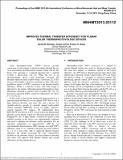Improved Thermal Transfer Efficiency for Planar Solar Thermophotovoltaic Devices
Author(s)
Bierman, David Matthew; Lenert, Andrej; Wang, Evelyn
Downloadv001t05a005-mnhmt2013-22112.pdf (1.207Mb)
PUBLISHER_POLICY
Publisher Policy
Article is made available in accordance with the publisher's policy and may be subject to US copyright law. Please refer to the publisher's site for terms of use.
Terms of use
Metadata
Show full item recordAbstract
Solar thermophotovoltaic (STPV) devices provide conversion of solar energy to electrical energy through the use of an intermediate absorber/emitter module, which converts the broad solar spectrum to a tailored spectrum that is emitted towards a photovoltaic cell. While the use of an absorber/emitter device could potentially overcome the Shockley-Queisser limit of photovoltaic conversion, it also increases the number of heat loss mechanisms. One of the most prohibitive aspects of STPV conversion is the thermal transfer efficiency, which is a measure of how well solar energy is delivered to the emitter. Although reported thermophotovoltaic efficiencies (thermal to electric) have exceeded 10%, previously measured STPV conversion efficiencies are below 1%. In this work, we present the design and characterization of a nanostructured absorber for use in a planar STPV device with a high emitter-to-absorber area ratio. We used a process for spatially-selective growth of vertically aligned multi-walled carbon nanotube (MWCNT) forests on highly reflective, smooth tungsten (W) surfaces. We implemented these MWCNT/W absorbers in a TPV system with a one-dimensional photonic crystal emitter, which was spectrally paired with a low bandgap PV cell. A high fidelity, system-level model of the radiative transfer in the device was experimentally validated and used to optimize the absorber surface geometry. For an operating temperature of approximately 1200 K, we experimentally demonstrated a 100% increase in overall STPV efficiency using a 4 to 1 emitter-to-absorber area ratio (relative to a 1 to 1 area ratio), due to improved thermal transfer efficiency. By further increasing the solar concentration incident on the absorber surface, increased emitter-to-absorber area ratios will improve both thermal transfer and overall efficiencies for these planar devices. Topics: Solar energy
Date issued
2013-12Department
Massachusetts Institute of Technology. Department of Mechanical EngineeringJournal
ASME 2013 4th International Conference on Micro/Nanoscale Heat and Mass Transfer
Publisher
American Society of Mechanical Engineers
Citation
Bierman, David M., Andrej Lenert, and Evelyn N. Wang. “Improved Thermal Transfer Efficiency for Planar Solar Thermophotovoltaic Devices.” ASME 2013 4th International Conference on Micro/Nanoscale Heat and Mass Transfer, 11-14, December, 2013, Hong Kong, China, ASME, 2013. © 2013 by ASME
Version: Final published version
ISBN
978-0-7918-5615-4